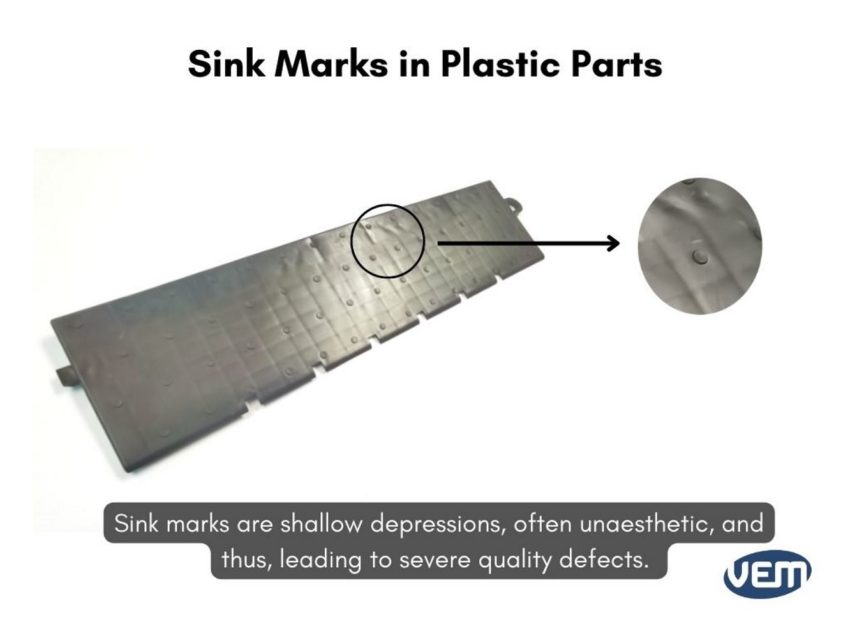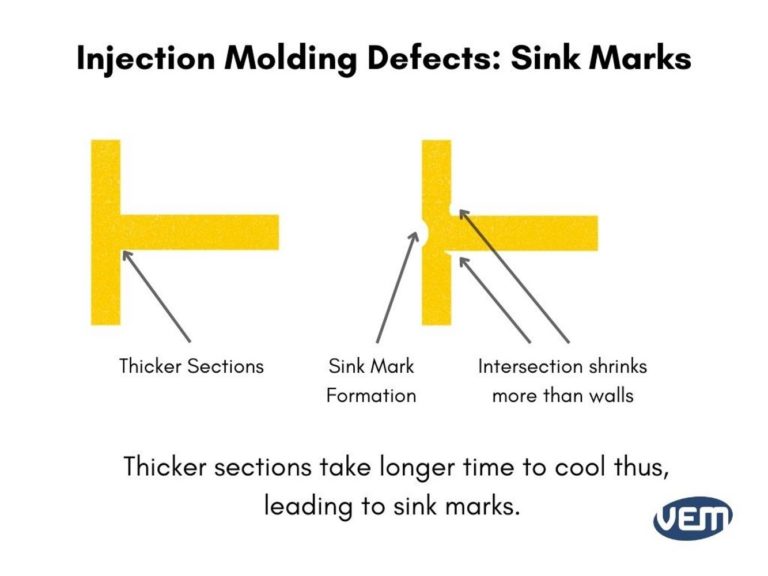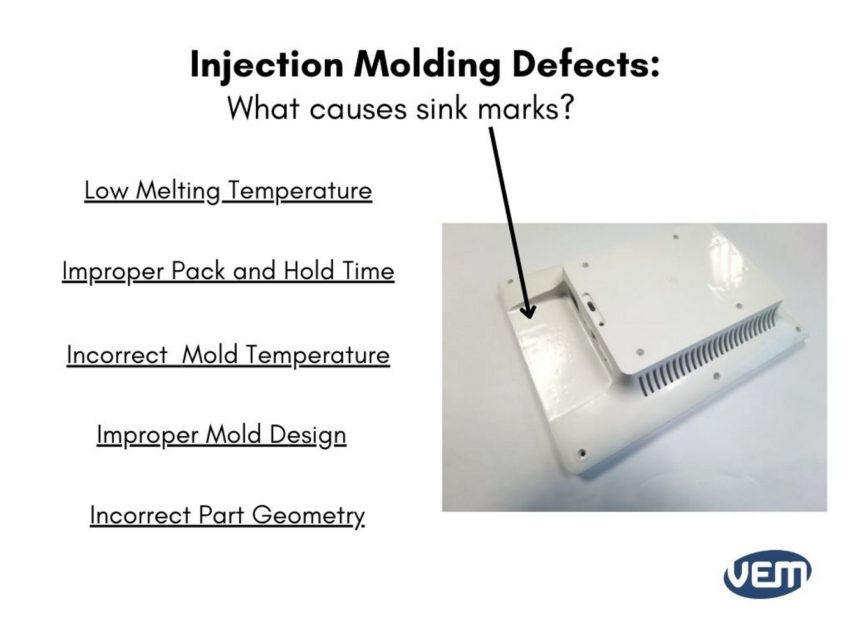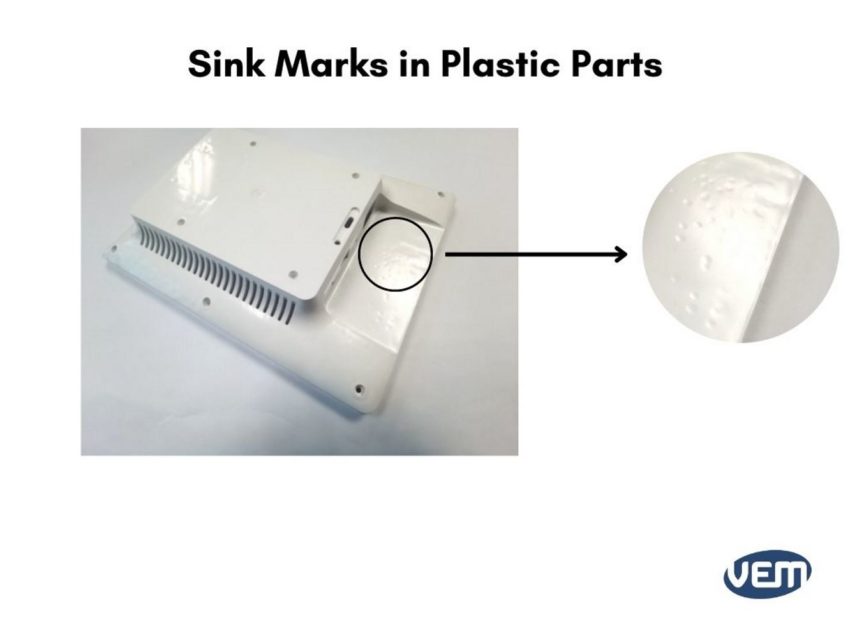

Injection molding defects hamper the manufacturing process by increasing the production costs. They either cause technical dysfunctionality in the plastic part or can lead to visually unappealing results. There are various types of injection molding defects that can cause such interruptions in the manufacturing cycle. Some of these are listed below:
In this article, we will show the formation of sink marks, how it affects the finished plastic part, and what can be done to avoid them.
Sink marks are one of the most common injection molding defects that usually occur as depressions in the thicker sections of the plastic part. Generally, these depressions are very small and they do not affect the strength or function of the plastic part but they are still visible. This can cause issues, especially for visual parts instead of medical parts.

Sink marks are formed where the thicker section of the part has more plastic, which takes longer to cool. In this case, the outer portion of the plastic part which is in contact with the mold cools faster than the internal portion. The result is that the molecules in thicker sections begin to contract. The molecules start to pull in on themselves, which leaves a defect known as ‘sink marks’. This is referred to as thermal contraction.

Sink marks are formed essentially due to high volumetric shrinkage. In addition, short packing and cooling time can also cause this particular defect.
The following gallery showcases injection molded parts with sink line defects:
Sink marks primarily occur due to thermal contraction but what are the causes for this to occur in injection molding? Let’s understand the various causes that lead to the formation of sink marks in injection molding:

It is essential to apply the optimum melting temperature of the plastic resin because sink marks are often caused due to the low temperature of the plastic material. This can be avoided by adjusting the temperature range of the melting resin, before injecting the molten plastic into the mold.
The next factor that can cause sink marks in your plastic part is improper holding pressure distribution.
The pack and hold time should be set long to ensure apt sealing of the part gate. This prevents the entry and exit of plastic resin from the mold cavity.
To avoid sink marks, it should be held long enough to ensure that the gate solidifies after filling the mold. This would help prevent melted material from exiting the mold thus, preventing sinks. In other words, when a mark or depression occurs near the gate, then it helps to eradicate the formation of sink marks by prolonging the pack and hold time.
Thus, applying proper packing pressure to different parts of the product can help to keep it in shape. To prevent sink marks, a typical mold cavity pressure should be between 8000–15,000 psi (550-1030 bar). Generally, the pack or hold pressure should be between 50-70% of injection pressure.
The next factor that can cause sink marks is an incorrect mold temperature. It is recommended to keep the mold temperature between 80-120℃ / 176-248℉. If the temperature is too high, it could deter the gate from sealing properly on time. This can be avoided by using the correct mold temperature range while also, ensuring correct plumbing.
The next factor that can cause sink marks is incorrect part geometry in the mold design. Part design plays a major role in the formation of sink marks. It depends upon various factors such as ribs, bosses, uniform wall thickness, wall thickness variation, mold wall thickness, etc.
The depressions are generally caused near the ribs and bosses and here are a few ways to avoid the formation of sink marks defects:
Molten plastic flows along the path with little or no resistance thus, the lesser thick areas fill up first. After this, the section is filled completely with molten plastic, and further, it starts filling the rib sections.
Injection molders can aim to create a balance between rib and wall thickness. They should also avoid increasing the height of the rib to the thickness of the wall because this can lead to an increment of defects.
Sink marks can be minimized by incorporating a gradual 7-degree slope at the rib base. This method works only when the gate is near the area. This slope helps ensure a gradual rise in the molten material injected into the mold, thus, preventing the formation of sink marks.
The boss should be designed in a way that the hoop undergoes minimal stress. It is recommended to design such that the outside diameter should be double the inside diameter. This type of boss design helps to reduce the formation of sink marks.
In order to avoid sink marks, wall thickness should be uniform throughout in plastic design. This factor needs to be ensured in the initial design stage. If this factor is overlooked, it can result in a constrained process. Typically, the wall thickness should be between 0.5mm to 5mm, but needs to be suitable for the individual part.
In general, molten plastic just like other liquids tends to flow freely through conduits with the least resistance thus, if there is variation in wall thickness, the molten resin would first, flow freely through the thicker regions than the thinner sections. This can cause imbalanced filling of cavities, trapped air in the tool and development of weld lines, and sink marks. Thus, it is essential to ensure uniform wall thickness.
Sink mark depressions are caused by uneven cooling of the molten resins. We enlisted some of the causes above and these causes are primarily where the boss and rib meet a wall, a large solid region, or an area, where the wall thickness changes. Thus, sink marks can be avoided by correcting these causes.

Injection molding defects can significantly hamper the manufacturing process by increasing production costs. It also leads to wastage of resources and increases the cycle time thus, it’s imperative to be proactive during the product development process.
You can contact VEM Tooling to understand how we can help you reduce the occurrence of defects in your product manufacturing process. At VEM Tooling, we can use 3D modeling (a powerful software solution for plastic part designing) to determine thickness analysis for our part assessment. This helps us to make possible feature modifications to reduce the occurrence of sink marks.